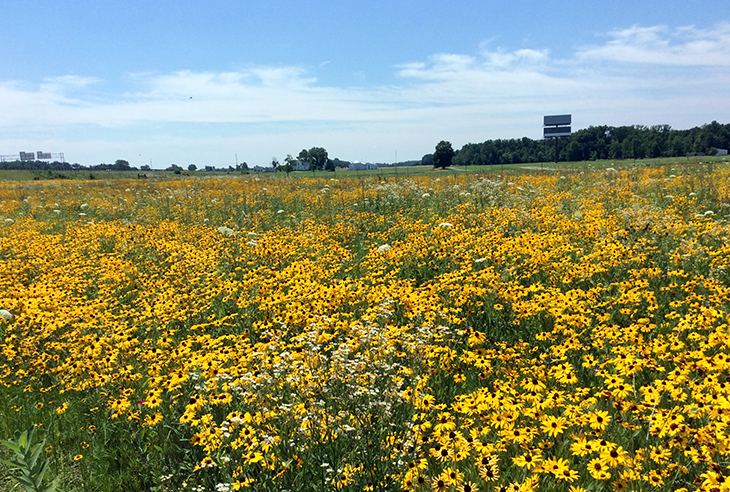
June 25, 2021
Pollinators like bees, butterflies, beetles, birds and some mammals provide a critically essential ecosystem service — they help plants reproduce. Without them, we’d lose about a third of the global food supply.
Yet pollinators have been declining over the past several decades, with scientists pointing to issues like habitat destruction, climate change and pesticide use. As of 2020, more than 70 pollinator species native to the U.S. are listed as endangered or threatened under the Endangered Species Act. Some species have disappeared from Ohio completely, said John Kaiser, private lands program administrator for the Ohio Department of Natural Resources (ODNR) Division of Wildlife.
“We have many landscapes, whether urban or agriculture, where it’s a monoculture of plants — it’s all lawn or it’s all soybeans or corn. But pollinators need a diversity of plants, trees and shrubs that are blooming all throughout the season — spring, summer and fall,” Kaiser said.
To help improve Ohio’s pollinator potential, the ODNR private lands program provides free technical advice and assistance to landowners who want to create or enhance pollinator habitat on their property. The program also connects landowners with resources from the Ohio Pollinator Habitat Initiative and helps them take advantage of federal programs that can offset costs involved in establishing habitat, like the Environmental Quality Incentives Program or Conservation Reserve Program.
“The more diversity of plant life we have in the landscape, especially native plant life, the better off pollinators are going to be,” Kaiser said.
The Ohio Department of Transportation (ODOT) is also playing an important role in pollinator conservation through its Pollinator Habitat Program, said Scott Lucas, assistant administrator of ODOT’s Office of Maintenance Operations. To date, ODOT has created over 120 roadside pollinator habitats, each of which boasts four species of blooming plants throughout spring, summer and fall.
“If you don’t have good food, you’re not going to get better — it’s the same for pollinators. So we provide three seasons of good food for them,” Lucas said.
Because many pollinators hibernate in leaves or the stems of plants, ODOT also leaves the habitat areas alone in winter, only mowing once in the spring after pollinators have awoken from hibernation. Responsible pesticide use — such as spot application versus blanket application — is another key component of ODOT’s pollinator work, Lucas said.
Seeds coated in neonicotinoid pesticides are a major concern for pollinators, as the pesticide can become airborne in the wind and carried to surrounding trees and other plant life, Kaiser said, adding that ODNR has implemented a new policy banning the use of neonicotinoid seeds on its publicly managed land.
“Our cropping practices have certainly diminished pollinator habitat on a large scale,” said Terry Lavy, owner of the Conservationist, LLC, in Covington, Ohio, which creates and manages wildlife habitat on public and private land. Lavy said he is committed to the responsible use of herbicides and pesticides, only using them at strategic times to control or clear invasive plants and make room for native plants.
“Spraying a field with herbicide to get it ready to plant wildflowers is a completely different situation then spraying a field to get rid of all the milkweed,” Lavy said.
In ways big and small, the wildlife profession is increasingly learning to take pollinators into account when managing public and private land. And the benefits are sure to make an impact.
“Protecting pollinators is good for all wildlife, and it’s good for humans,” Lucas said.